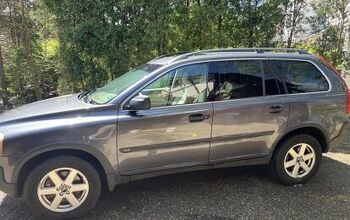2017 Toyota Prius Review - Don't Make Fun of the Nerds

2017 Toyota Prius Hybrid
Attentive readers will have, by now, recognized that my automotive choices tend to run towards the, shall we say, flamboyant side. Our family daily is an inky-black Dodge Charger with a vanity plate which is guaranteed to enrage bumper-ogling Methodists. New, oversized rims are scheduled to be fitted the minute all this snow goes away. Meanwhile, the Ram 1500 with which the Charger shares driveway space is painted Look-At-Me Red, accented garishly nicely with chrome 20-inch rims. I drove a Lincoln Mark VII with an uncorked exhaust for many years. My neighbours love me.
So what am I doing in a Prius when my tastes tilt to the extrovert end of the spectrum? Well, it’s always fun to see how the other half lives, and in this case, I wanted to see how the thing would fare on a 1,000-mile journey in the dead of winter.
If I sought winter conditions to test the Prius, then the Canadian East Coast did not disappoint. The day before I was scheduled to leave, well over two feet of cold and misery fell from the sky, blanketing everything in a deep white power and making the place look like a record producer’s office. The Prius would be out of its element, then.
For 2017, the Prius’ Hybrid Synergy Drive combines the output of its gasoline engine and two motors/generators that shuttle power to its front wheels through an electronically controlled CVT. This shift-by-wire technology is controlled by an odd dash-mounted shifter, which sprouts from beneath the climate controls like an errant Atari joystick. The 1.8-litre four-cylinder gasoline engine makes 95 horsepower and runs on regular fuel while working in concert with the hybrid system to create a peak combined power output of 121 hp.
Spread out before the driver is a digital buffet of data, simultaneously creating some great information displays and odd ergonomic excrescences. Speed and hybrid system details are presented in large Day-Glo readouts; this, I like. But the array of warning lights that are actually closer to the passenger than the driver? Not so much. A large touchscreen in the centre stack controls audio and nav functions, and will be familiar to any modern Corolla driver.
Our tester was equipped in mid-range trim and delivered niceties such as rain sensing wipers, Softex (read: leather) seats, and a nifty heads-up display. The HUD was quite useful and offered a multitude of different displays, such as clear and animated navigation info that would usurp the planet-saving admonishments when necessary. The seats were astonishingly comfortable, definitely fit for 12-hour stints behind the wheel. This is significantly more than I can say for the driver’s door mounted armrest, whose surface is the only substance on the planet harder than a diamond. It wasn’t long into the trip that I stuffed my winter toque under my elbow to forestall discomfort.
An oddity in the Prius’ interior was its emergency brake. An old-fashioned foot pump, and not a modern electric unit, seemed extremely out-of-place in such a futuristic car. It was not unlike strolling onto the bridge of the Enterprise and finding Captain Picard tending to a wood stove.
The wind-cheating exterior shape of the Prius is, like haggis or cod tongues, an acquired taste. Its convoluted assemblage of sharp angles and flat surfaces assure drivers they won’t lose it in a parking lot. Suddenly, then, the Prius appears on this extrovert’s radar in terms of outrageous looks, particularly the soaring lightsabre taillights.
Think what you will of Toyota’s latest sojourn into creative styling cues, but at least we’re talking about them. The previous-generation Prius had some interesting design choices, especially compared to the original Prius. In Gen-2, it was as if your sedate math teacher suddenly started wearing Under Armour hoodies and turning his cap backwards. The effort was made but it was still easy to catch a whiff of Ben-Gay. With the current Prius, that same math teacher went and got two tattoo sleeves and a nose ring. It’s extroverted, jarring, and controversial.
It’s worth noting the 2017 Prius features modern lithium-ion batteries and not nickel-metal hydride units in all but base trim, nixing arguments that building a Prius involves the messy matter of mining nickel out of the earth’s crust and shipping it to a factory halfway around the world.
I expected a Spartan experience in the Prius, mixed with a heavy dose of granola. It would not have surprised me if the Prius required me to wear a multi-ethnic, nuclear-free, world-peace burlap sack to realize any sort of meaningful efficiency. In reality, I enjoyed comfortable leather seats, satellite radio, all manner of USB connections for my tunes, and large sunroof. My own Look-At-Me truck is equally equipped with these features.
The Prius acquitted itself well on the journey, handling like a typical front-drive hatchback in the snow (again, the lack-of-sacrifice theme emerges). Zipping through the French delights of Montreal, the Prius needed some hard prods of the go-pedal to keep up with traffic, causing the CVT to zing up in the power peak and stay there, creating an unpleasant mechanical moo.
Some back-of-napkin math revealed an astounding fuel-economy average of 49 miles per gallon (4.8L/100km), consuming 20.9 gallons (79 liters) of regular fuel over 1,028 miles (1,655 km). This dented my debit card to the tune of $84.51 CAD ($63.08 USD at the time of writing). I employed no hypermiling techniques and made liberal use of the defroster and heated seats. A few years ago, I did this same trip in a Fiat 500 Turbo, achieving an efficiency of 33 mpg (7.2L/100km).
Will a Prius be joining my fleet of over-the-top machinery? Hardly. But I will concede it left me surprised by the lack of demanded sacrifice to achieve stellar fuel economy numbers in less than ideal conditions. Some Prius owners might be supremely smug and annoying, but I certainly came away with a different opinion of the car itself. It’s easy to make fun of nerds, yet, at the end of the day, they’re often the ones who think outside the box and create something popular … and make a ton of money doing it.

Matthew buys, sells, fixes, & races cars. As a human index of auto & auction knowledge, he is fond of making money and offering loud opinions.
More by Matthew Guy
Latest Car Reviews
Read moreLatest Product Reviews
Read moreRecent Comments
- Redapple2 Dear lord ! That face. HARD NO.
- Urlik Let’s ban for all. Having that data anywhere leaves it open to the Chinese government potentially hacking systems to get the data.
- Redapple2 Gen 1 - 8/10 on cool scale.Gen 2 - 3/10.
- SCE to AUX "...to help bolster job growth and the local economy"An easy win for the politicians - the details won't matter.
- Kjhkjlhkjhkljh kljhjkhjklhkjh so now we will PAY them your tax money to build crappy cars in the states ..








































Comments
Join the conversation
My sister long had a 2005 Prius which she donated to my parents. It's a good car...tons of useful cargo space and it runs forever on a tank of gas. But it's slow. As long as you don't mind that, you will have a reasonably good daily driver for the city. The Prius has two batteries, both the big hybrid battery and a secondary one. You will have problems with both and will have to replace them, but probably just once or twice.
I seem to like more "variety" in cars than Mr. Guy, having a Corvette and Mini Cooper, as well as a Prius. The Corvette and Mini are fun, for different reasons, but if I had only one car, it would probably be a Prius. I like the liftback utility and the 45-50 mpg "no matter what" efficiency. I also like the impossible-to-abuse powertrain with no clutches or shift elements. The new, 4th generation Prius even handles and rides decently, compared to most other FWD cars its size.